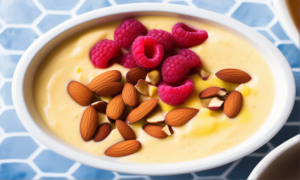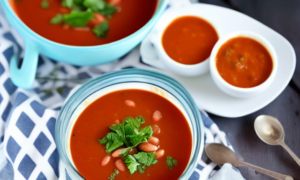 Nutrient-Rich Tomato Soup with Beans & Greens
Introduction:
Transform ordinary canned tomato soup into a hearty and wholesome meal in just 10 minutes! Garlicky kale and creamy white beans add depth and nutritional value to this quick and satisfying lunch or dinner option. This recipe is designed to be diabetes-friendly, emphasizing low-sodium choices and incorporating nutrient-rich ingredients.
Ingredients:
2 (14 ounce) cans low-sodium hearty-style tomato soup
1 tablespoon olive oil
3 cups chopped kale
1 teaspoon minced garlic
⅛ teaspoon crushed red pepper (Optional)
1 (14 ounce) can no-salt-added cannellini beans, rinsed
¼ cup grated Parmesan cheese
Directions:
Heat the tomato soup in a medium saucepan according to package directions; simmer over low heat while preparing the kale.
In a large skillet over medium heat, heat olive oil. Add kale and cook, stirring, until wilted, approximately 1 to 2 minutes. Stir in minced garlic and crushed red pepper (if using), cooking for an additional 30 seconds. Combine the sautéed greens and beans into the soup, simmering until the beans are heated through, around 2 to 3 minutes.
Divide the soup evenly among 4 bowls. Serve each portion topped with a sprinkle of Parmesan.
Diabetes-Friendly Features:
Low-Sodium Soup: Choose a low- or reduced-sodium tomato soup with no more than 450 mg sodium per serving, supporting heart health.
Leafy Greens: Kale adds essential vitamins and fiber without significantly affecting blood sugar levels.
Beans for Sustained Energy: Cannellini beans provide a protein and fiber boost, promoting stable blood sugar.
Healthy Fats: Olive oil contributes healthy monounsaturated fats, beneficial for cardiovascular health.
Moderate Parmesan Topping: A modest amount of Parmesan adds flavor without excess salt, complementing the dish.
Nutrient-Rich Tomato Soup with Beans & Greens
Introduction:
Transform ordinary canned tomato soup into a hearty and wholesome meal in just 10 minutes! Garlicky kale and creamy white beans add depth and nutritional value to this quick and satisfying lunch or dinner option. This recipe is designed to be diabetes-friendly, emphasizing low-sodium choices and incorporating nutrient-rich ingredients.
Ingredients:
2 (14 ounce) cans low-sodium hearty-style tomato soup
1 tablespoon olive oil
3 cups chopped kale
1 teaspoon minced garlic
⅛ teaspoon crushed red pepper (Optional)
1 (14 ounce) can no-salt-added cannellini beans, rinsed
¼ cup grated Parmesan cheese
Directions:
Heat the tomato soup in a medium saucepan according to package directions; simmer over low heat while preparing the kale.
In a large skillet over medium heat, heat olive oil. Add kale and cook, stirring, until wilted, approximately 1 to 2 minutes. Stir in minced garlic and crushed red pepper (if using), cooking for an additional 30 seconds. Combine the sautéed greens and beans into the soup, simmering until the beans are heated through, around 2 to 3 minutes.
Divide the soup evenly among 4 bowls. Serve each portion topped with a sprinkle of Parmesan.
Diabetes-Friendly Features:
Low-Sodium Soup: Choose a low- or reduced-sodium tomato soup with no more than 450 mg sodium per serving, supporting heart health.
Leafy Greens: Kale adds essential vitamins and fiber without significantly affecting blood sugar levels.
Beans for Sustained Energy: Cannellini beans provide a protein and fiber boost, promoting stable blood sugar.
Healthy Fats: Olive oil contributes healthy monounsaturated fats, beneficial for cardiovascular health.
Moderate Parmesan Topping: A modest amount of Parmesan adds flavor without excess salt, complementing the dish.
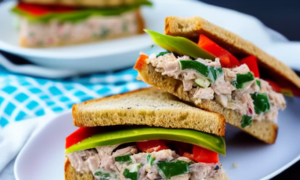 Quick and Delicious 10-Minute Tuna Melt
Introduction:
This variation of a classic sandwich uses mayonnaise, but not where you think! Mayo is brushed on the outside of the sandwich in place of butter to make the sandwich golden and crispy as it heats in a skillet. Plain Greek yogurt takes mayo's place in the salad—along with crunchy celery, roasted red bell peppers, and scallions—for a satisfying lunch with less saturated fat.
Ingredients:
1 5-ounce can no-salt-added water-packed tuna, drained
1 small celery stalk, chopped
2 tablespoons chopped jarred roasted red pepper
1 scallion, minced
3 tablespoons low-fat plain Greek yogurt
1 teaspoon Dijon mustard
¼ teaspoon ground pepper
4 teaspoons mayonnaise or softened butter
4 slices whole-grain bread
2 slices sharp Cheddar cheese
Directions:
Stir tuna, celery, roasted red pepper, scallion, yogurt, mustard, and pepper together in a medium bowl until well blended.
Spread 1 teaspoon mayonnaise (or butter) on one side of each slice of bread. Flip 2 of the slices and top each with half of the tuna mixture, 1 slice cheese, and another slice of bread, mayonnaise-side up.
Heat a large skillet over medium heat. Place the sandwiches in the pan and cook, turning once, until the cheese is melted and the bread is golden, 3 to 5 minutes per side. Serve immediately.
Diabetes-Friendly Features:
Low Saturated Fat: Substitute low-fat Greek yogurt for mayonnaise to reduce saturated fat intake.
Whole-Grain Bread: Opt for whole-grain bread for stable carbohydrates, aiding in blood sugar management.
Vegetables and Protein: With celery, roasted red pepper, and tuna, it provides a balanced mix of vegetables and protein, helping control blood sugar.
Portion Control: The recipe emphasizes moderate ingredient quantities, aligning with diabetes dietary principles.
Quick and Delicious 10-Minute Tuna Melt
Introduction:
This variation of a classic sandwich uses mayonnaise, but not where you think! Mayo is brushed on the outside of the sandwich in place of butter to make the sandwich golden and crispy as it heats in a skillet. Plain Greek yogurt takes mayo's place in the salad—along with crunchy celery, roasted red bell peppers, and scallions—for a satisfying lunch with less saturated fat.
Ingredients:
1 5-ounce can no-salt-added water-packed tuna, drained
1 small celery stalk, chopped
2 tablespoons chopped jarred roasted red pepper
1 scallion, minced
3 tablespoons low-fat plain Greek yogurt
1 teaspoon Dijon mustard
¼ teaspoon ground pepper
4 teaspoons mayonnaise or softened butter
4 slices whole-grain bread
2 slices sharp Cheddar cheese
Directions:
Stir tuna, celery, roasted red pepper, scallion, yogurt, mustard, and pepper together in a medium bowl until well blended.
Spread 1 teaspoon mayonnaise (or butter) on one side of each slice of bread. Flip 2 of the slices and top each with half of the tuna mixture, 1 slice cheese, and another slice of bread, mayonnaise-side up.
Heat a large skillet over medium heat. Place the sandwiches in the pan and cook, turning once, until the cheese is melted and the bread is golden, 3 to 5 minutes per side. Serve immediately.
Diabetes-Friendly Features:
Low Saturated Fat: Substitute low-fat Greek yogurt for mayonnaise to reduce saturated fat intake.
Whole-Grain Bread: Opt for whole-grain bread for stable carbohydrates, aiding in blood sugar management.
Vegetables and Protein: With celery, roasted red pepper, and tuna, it provides a balanced mix of vegetables and protein, helping control blood sugar.
Portion Control: The recipe emphasizes moderate ingredient quantities, aligning with diabetes dietary principles.
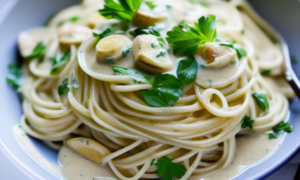 Linguine with Creamy White Clam Sauce
Overview:
Indulge in the delightful flavors of Linguine with Creamy White Clam Sauce, featuring ripe tomatoes, fresh basil, and tender clams. This quick and healthy pasta dish not only satisfies your taste buds but is also diabetes-friendly, offering a balance of wholesome ingredients.
Ingredients:
8 ounces whole-wheat linguine
1 16-ounce container chopped clams (thawed if frozen) or two 10-ounce cans whole baby clams
3 tablespoons extra-virgin olive oil
3 cloves garlic, chopped
¼ teaspoon crushed red pepper
1 tablespoon lemon juice
¼ teaspoon salt
1 large tomato, chopped
¼ cup chopped fresh basil, plus more for garnish
2 tablespoons heavy cream or half-and-half
Directions:
Bring a large saucepan of water to a boil. Add pasta and cook until just tender, about 8 minutes or according to package directions. Drain.
Meanwhile, drain clams, reserving 3/4 cup of the liquid. Heat oil in a large skillet over medium-high heat. Add garlic and crushed red pepper and cook, stirring, for 30 seconds.
Add the reserved clam liquid, lemon juice, and salt; bring to a simmer and cook until slightly reduced, 2 to 3 minutes. Add tomato and the clams; bring to a simmer and cook for 1 minute more. Remove from heat.
Stir in basil and cream (or half-and-half). Add the pasta and toss to coat with the sauce. Garnish with more basil, if desired.
Diabetes-Friendly Features:
Whole-Wheat Linguine: Incorporating whole grains provides complex carbohydrates, promoting steady blood sugar levels.
Fresh Ingredients: Ripe tomatoes and basil contribute natural flavors without added sugars, enhancing the nutritional profile.
Lean Protein: Clams offer protein without excessive fat, supporting a balanced meal for those managing diabetes.
Moderate Portions: The recipe emphasizes portion control, a crucial aspect of diabetes management.
Low-Sodium Option: Choosing fresh or frozen clams lowers sodium content compared to canned, aligning with dietary considerations for diabetes.
Linguine with Creamy White Clam Sauce
Overview:
Indulge in the delightful flavors of Linguine with Creamy White Clam Sauce, featuring ripe tomatoes, fresh basil, and tender clams. This quick and healthy pasta dish not only satisfies your taste buds but is also diabetes-friendly, offering a balance of wholesome ingredients.
Ingredients:
8 ounces whole-wheat linguine
1 16-ounce container chopped clams (thawed if frozen) or two 10-ounce cans whole baby clams
3 tablespoons extra-virgin olive oil
3 cloves garlic, chopped
¼ teaspoon crushed red pepper
1 tablespoon lemon juice
¼ teaspoon salt
1 large tomato, chopped
¼ cup chopped fresh basil, plus more for garnish
2 tablespoons heavy cream or half-and-half
Directions:
Bring a large saucepan of water to a boil. Add pasta and cook until just tender, about 8 minutes or according to package directions. Drain.
Meanwhile, drain clams, reserving 3/4 cup of the liquid. Heat oil in a large skillet over medium-high heat. Add garlic and crushed red pepper and cook, stirring, for 30 seconds.
Add the reserved clam liquid, lemon juice, and salt; bring to a simmer and cook until slightly reduced, 2 to 3 minutes. Add tomato and the clams; bring to a simmer and cook for 1 minute more. Remove from heat.
Stir in basil and cream (or half-and-half). Add the pasta and toss to coat with the sauce. Garnish with more basil, if desired.
Diabetes-Friendly Features:
Whole-Wheat Linguine: Incorporating whole grains provides complex carbohydrates, promoting steady blood sugar levels.
Fresh Ingredients: Ripe tomatoes and basil contribute natural flavors without added sugars, enhancing the nutritional profile.
Lean Protein: Clams offer protein without excessive fat, supporting a balanced meal for those managing diabetes.
Moderate Portions: The recipe emphasizes portion control, a crucial aspect of diabetes management.
Low-Sodium Option: Choosing fresh or frozen clams lowers sodium content compared to canned, aligning with dietary considerations for diabetes.
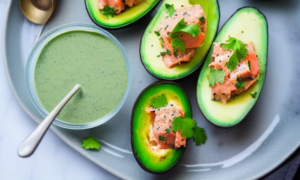 Salmon-Stuffed Avocados
Overview:
Embrace a heart-healthy and diabetes-friendly meal with these Salmon-Stuffed Avocados. Featuring canned salmon, rich in omega-3 fatty acids, and avocados for a dose of wholesome fats, this no-cook dish is not only nutritious but also a convenient addition to your diabetes-friendly recipes.
Ingredients:
½ cup nonfat plain Greek yogurt
½ cup diced celery
2 tablespoons chopped fresh parsley
1 tablespoon lime juice
2 teaspoons mayonnaise
1 teaspoon Dijon mustard
⅛ teaspoon salt
⅛ teaspoon ground pepper
2 (5-ounce) cans salmon, drained, flaked, skin and bones removed
2 avocados
Chopped chives for garnish
Directions:
In a medium bowl, combine yogurt, celery, parsley, lime juice, mayonnaise, mustard, salt, and pepper. Mix well.
Add the drained and flaked salmon to the bowl and mix thoroughly.
Halve the avocados lengthwise, remove pits, and scoop about 1 tablespoon of flesh from each avocado half into a small bowl.
Mash the scooped-out avocado flesh with a fork and stir it into the salmon mixture.
Fill each avocado half with about 1/4 cup of the salmon mixture, mounding it on top of the avocado halves.
Garnish with chopped chives if desired.
Suitable for Diabetics:
This recipe is a diabetes-friendly choice as it incorporates nutrient-dense ingredients. Avocados offer healthy fats and fiber, while Greek yogurt provides protein without added sugars. The omega-3 fatty acids in salmon contribute to heart health, making it a balanced and delicious option for individuals managing diabetes.
Salmon-Stuffed Avocados
Overview:
Embrace a heart-healthy and diabetes-friendly meal with these Salmon-Stuffed Avocados. Featuring canned salmon, rich in omega-3 fatty acids, and avocados for a dose of wholesome fats, this no-cook dish is not only nutritious but also a convenient addition to your diabetes-friendly recipes.
Ingredients:
½ cup nonfat plain Greek yogurt
½ cup diced celery
2 tablespoons chopped fresh parsley
1 tablespoon lime juice
2 teaspoons mayonnaise
1 teaspoon Dijon mustard
⅛ teaspoon salt
⅛ teaspoon ground pepper
2 (5-ounce) cans salmon, drained, flaked, skin and bones removed
2 avocados
Chopped chives for garnish
Directions:
In a medium bowl, combine yogurt, celery, parsley, lime juice, mayonnaise, mustard, salt, and pepper. Mix well.
Add the drained and flaked salmon to the bowl and mix thoroughly.
Halve the avocados lengthwise, remove pits, and scoop about 1 tablespoon of flesh from each avocado half into a small bowl.
Mash the scooped-out avocado flesh with a fork and stir it into the salmon mixture.
Fill each avocado half with about 1/4 cup of the salmon mixture, mounding it on top of the avocado halves.
Garnish with chopped chives if desired.
Suitable for Diabetics:
This recipe is a diabetes-friendly choice as it incorporates nutrient-dense ingredients. Avocados offer healthy fats and fiber, while Greek yogurt provides protein without added sugars. The omega-3 fatty acids in salmon contribute to heart health, making it a balanced and delicious option for individuals managing diabetes.
 Quick Lemon Chicken Pasta
Overview:
Indulge in the fresh and flavorful delight of this Quick Lemon Chicken Pasta, a rapid and nutritious dinner option. Utilizing rotisserie chicken, spiralized zucchini, and the brightness of lemon, this dish is a delectable full meal ready in just 10 minutes!
Ingredients:
2 teaspoons extra-virgin olive oil
1 cup spiralized zucchini (see Tip)
1 cup baby spinach
½ cup shredded skinless rotisserie chicken breast
⅛ teaspoon salt
⅛ teaspoon ground pepper
½ cup cooked whole-wheat spaghetti
2 tablespoons grated Parmesan cheese
1 teaspoon grated lemon zest
1 tablespoon fresh lemon juice
1 tablespoon toasted panko breadcrumbs (see Tip)
Directions:
Heat oil in a large nonstick skillet over medium heat. Add zucchini; cook for 1 minute. Add spinach and chicken; cook for 1 more minute. Season with salt and pepper; remove from heat. Add cooked spaghetti, Parmesan, lemon zest, and lemon juice; toss to combine. Sprinkle with toasted panko and serve.
Tips:
Make your own zucchini noodles with a spiralizer; you'll need 1 small zucchini (about 2 oz.) for 1 cup of zoodles. Or look for a package of fresh zucchini noodles in the produce department.
To toast panko breadcrumbs: Set a small skillet over medium heat. Add panko and cook, stirring often, until golden, about 2 minutes. For extra flavor, melt 1 tsp. butter in the pan before toasting the breadcrumbs. Note that you can do this step first, using the same pan you'll use to prepare the rest of the recipe.
Suitable for Diabetics:
This recipe is light, low in calories, and an excellent choice for individuals with diabetes. Combining spiralized zucchini and whole-wheat spaghetti provides fiber and complex carbohydrates. The addition of lemon juice enhances the flavor without compromising blood sugar levels.
Quick Lemon Chicken Pasta
Overview:
Indulge in the fresh and flavorful delight of this Quick Lemon Chicken Pasta, a rapid and nutritious dinner option. Utilizing rotisserie chicken, spiralized zucchini, and the brightness of lemon, this dish is a delectable full meal ready in just 10 minutes!
Ingredients:
2 teaspoons extra-virgin olive oil
1 cup spiralized zucchini (see Tip)
1 cup baby spinach
½ cup shredded skinless rotisserie chicken breast
⅛ teaspoon salt
⅛ teaspoon ground pepper
½ cup cooked whole-wheat spaghetti
2 tablespoons grated Parmesan cheese
1 teaspoon grated lemon zest
1 tablespoon fresh lemon juice
1 tablespoon toasted panko breadcrumbs (see Tip)
Directions:
Heat oil in a large nonstick skillet over medium heat. Add zucchini; cook for 1 minute. Add spinach and chicken; cook for 1 more minute. Season with salt and pepper; remove from heat. Add cooked spaghetti, Parmesan, lemon zest, and lemon juice; toss to combine. Sprinkle with toasted panko and serve.
Tips:
Make your own zucchini noodles with a spiralizer; you'll need 1 small zucchini (about 2 oz.) for 1 cup of zoodles. Or look for a package of fresh zucchini noodles in the produce department.
To toast panko breadcrumbs: Set a small skillet over medium heat. Add panko and cook, stirring often, until golden, about 2 minutes. For extra flavor, melt 1 tsp. butter in the pan before toasting the breadcrumbs. Note that you can do this step first, using the same pan you'll use to prepare the rest of the recipe.
Suitable for Diabetics:
This recipe is light, low in calories, and an excellent choice for individuals with diabetes. Combining spiralized zucchini and whole-wheat spaghetti provides fiber and complex carbohydrates. The addition of lemon juice enhances the flavor without compromising blood sugar levels.
 Diabetes-Friendly One-Pan Chicken & Cabbage with Rice
Overview:
Indulge in the delightful flavors of this One-Pan Chicken & Cabbage with Rice—a tasteful and diabetes-friendly dish. Crafted with a balance of wholesome ingredients, this recipe ensures a delicious and nourishing experience for individuals managing diabetes.
Ingredients:
2 1/4 cups reduced-sodium chicken broth
2 tablespoons lemon juice
1 tablespoon Dijon mustard
1 teaspoon chopped fresh oregano, plus more for garnish
2 tablespoons extra-virgin olive oil, divided
3/4 teaspoon salt, divided
1/2 teaspoon ground pepper, divided
4 (6-ounce) bone-in, skin-on chicken thighs
1 small head green cabbage (about 16 ounces), cut into 6 (1 1/2- to 2-inch-thick) wedges
1 cup brown basmati rice
1/4 cup crumbled feta cheese
Lemon wedges for serving (optional)
Directions:
Preheat oven to 350°F. Whisk broth, lemon juice, mustard, oregano, 1 tablespoon oil, 1/2 teaspoon salt, and 1/4 teaspoon pepper together in a medium bowl until combined.
Sprinkle chicken with the remaining 1/4 teaspoon each salt and pepper. Heat the remaining 1 tablespoon oil in a large oven-safe skillet over medium-high heat. Add the chicken, skin-sides down; cook until the skins are golden brown and crispy, about 6 minutes. Transfer the chicken to a plate.
Add cabbage wedges to the pan; cook until slightly charred and beginning to become tender, 2 to 3 minutes per side. Transfer to a separate plate.
Reduce heat to medium; cook rice, stirring constantly, until toasted and fragrant, about 1 minute. Stir in the broth mixture until evenly combined.
Nestle the cabbage wedges and the chicken, skin-sides up, in a single layer in the rice mixture. Bring to a boil over medium-high heat. Remove from heat and cover with a tight-fitting lid.
Transfer to the oven and bake until the liquid is absorbed, the rice is tender, and an instant-read thermometer inserted into the thickest portion of chicken registers at least 165°F, about 45 minutes. Remove the lid; bake until the chicken skins crisp up slightly, about 6 minutes. Top evenly with feta. Garnish with oregano and serve with lemon wedges, if desired.
Diabetes-Friendly Benefits:
This diabetes-friendly recipe incorporates brown basmati rice, a low-glycemic index option that helps regulate blood sugar levels. The chicken provides lean protein, and the cabbage contributes fiber and essential nutrients. The recipe is thoughtfully designed to maintain a balance between flavors and nutritional requirements, making it a wholesome and diabetes-conscious choice for a satisfying meal.
Diabetes-Friendly One-Pan Chicken & Cabbage with Rice
Overview:
Indulge in the delightful flavors of this One-Pan Chicken & Cabbage with Rice—a tasteful and diabetes-friendly dish. Crafted with a balance of wholesome ingredients, this recipe ensures a delicious and nourishing experience for individuals managing diabetes.
Ingredients:
2 1/4 cups reduced-sodium chicken broth
2 tablespoons lemon juice
1 tablespoon Dijon mustard
1 teaspoon chopped fresh oregano, plus more for garnish
2 tablespoons extra-virgin olive oil, divided
3/4 teaspoon salt, divided
1/2 teaspoon ground pepper, divided
4 (6-ounce) bone-in, skin-on chicken thighs
1 small head green cabbage (about 16 ounces), cut into 6 (1 1/2- to 2-inch-thick) wedges
1 cup brown basmati rice
1/4 cup crumbled feta cheese
Lemon wedges for serving (optional)
Directions:
Preheat oven to 350°F. Whisk broth, lemon juice, mustard, oregano, 1 tablespoon oil, 1/2 teaspoon salt, and 1/4 teaspoon pepper together in a medium bowl until combined.
Sprinkle chicken with the remaining 1/4 teaspoon each salt and pepper. Heat the remaining 1 tablespoon oil in a large oven-safe skillet over medium-high heat. Add the chicken, skin-sides down; cook until the skins are golden brown and crispy, about 6 minutes. Transfer the chicken to a plate.
Add cabbage wedges to the pan; cook until slightly charred and beginning to become tender, 2 to 3 minutes per side. Transfer to a separate plate.
Reduce heat to medium; cook rice, stirring constantly, until toasted and fragrant, about 1 minute. Stir in the broth mixture until evenly combined.
Nestle the cabbage wedges and the chicken, skin-sides up, in a single layer in the rice mixture. Bring to a boil over medium-high heat. Remove from heat and cover with a tight-fitting lid.
Transfer to the oven and bake until the liquid is absorbed, the rice is tender, and an instant-read thermometer inserted into the thickest portion of chicken registers at least 165°F, about 45 minutes. Remove the lid; bake until the chicken skins crisp up slightly, about 6 minutes. Top evenly with feta. Garnish with oregano and serve with lemon wedges, if desired.
Diabetes-Friendly Benefits:
This diabetes-friendly recipe incorporates brown basmati rice, a low-glycemic index option that helps regulate blood sugar levels. The chicken provides lean protein, and the cabbage contributes fiber and essential nutrients. The recipe is thoughtfully designed to maintain a balance between flavors and nutritional requirements, making it a wholesome and diabetes-conscious choice for a satisfying meal.
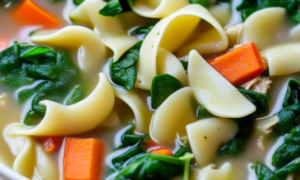 Diabetes-Friendly Chicken Noodle Soup with Spinach & Parmesan
Overview:
Delight in the comforting flavors of Chicken Noodle Soup with Spinach & Parmesan, a diabetes-friendly recipe that balances taste and nutritional benefits. This soup is thoughtfully crafted to cater to the dietary needs of individuals managing diabetes, ensuring a delicious and wholesome meal.
Ingredients:
2 tablespoons extra virgin olive oil
2 cloves garlic, thinly sliced
1/4 teaspoon crushed red pepper
1/3 cup dry white wine
6 cups low-sodium chicken broth
1/4 teaspoon salt
1/4 teaspoon ground pepper
1/2 cup whole-wheat small elbow pasta
2 cups shredded cooked chicken breast
1 (5-ounce) package baby spinach
1/2 teaspoon lemon zest
2 tablespoons lemon juice
1/3 cup finely grated Parmesan cheese
Directions:
Cook oil, garlic, and crushed red pepper in a medium saucepan over medium-high heat, stirring constantly until fragrant and sizzling, about 2 minutes. Stir in wine; cook, stirring once, until reduced by half, about 2 minutes.
Stir in broth, salt, and pepper. Cover and bring to a boil over high heat. Add pasta; cook, stirring occasionally, until al dente, about 6 minutes.
Remove from heat. Add chicken and spinach; stir until the spinach is wilted, about 1 minute. Stir in lemon zest and lemon juice.
Divide the soup among 4 shallow bowls; sprinkle with Parmesan.
Diabetes-Friendly Benefits:
This Chicken Noodle Soup is tailored for individuals managing diabetes. The whole-wheat pasta provides complex carbohydrates, promoting stable blood sugar levels. The addition of lean shredded chicken ensures a protein boost without excess saturated fats. Spinach, rich in fiber and essential nutrients, contributes to a balanced meal. The soup's flavor is elevated with a touch of white wine, garlic, and Parmesan, making it a satisfying and diabetes-conscious choice for a nourishing meal.
Diabetes-Friendly Chicken Noodle Soup with Spinach & Parmesan
Overview:
Delight in the comforting flavors of Chicken Noodle Soup with Spinach & Parmesan, a diabetes-friendly recipe that balances taste and nutritional benefits. This soup is thoughtfully crafted to cater to the dietary needs of individuals managing diabetes, ensuring a delicious and wholesome meal.
Ingredients:
2 tablespoons extra virgin olive oil
2 cloves garlic, thinly sliced
1/4 teaspoon crushed red pepper
1/3 cup dry white wine
6 cups low-sodium chicken broth
1/4 teaspoon salt
1/4 teaspoon ground pepper
1/2 cup whole-wheat small elbow pasta
2 cups shredded cooked chicken breast
1 (5-ounce) package baby spinach
1/2 teaspoon lemon zest
2 tablespoons lemon juice
1/3 cup finely grated Parmesan cheese
Directions:
Cook oil, garlic, and crushed red pepper in a medium saucepan over medium-high heat, stirring constantly until fragrant and sizzling, about 2 minutes. Stir in wine; cook, stirring once, until reduced by half, about 2 minutes.
Stir in broth, salt, and pepper. Cover and bring to a boil over high heat. Add pasta; cook, stirring occasionally, until al dente, about 6 minutes.
Remove from heat. Add chicken and spinach; stir until the spinach is wilted, about 1 minute. Stir in lemon zest and lemon juice.
Divide the soup among 4 shallow bowls; sprinkle with Parmesan.
Diabetes-Friendly Benefits:
This Chicken Noodle Soup is tailored for individuals managing diabetes. The whole-wheat pasta provides complex carbohydrates, promoting stable blood sugar levels. The addition of lean shredded chicken ensures a protein boost without excess saturated fats. Spinach, rich in fiber and essential nutrients, contributes to a balanced meal. The soup's flavor is elevated with a touch of white wine, garlic, and Parmesan, making it a satisfying and diabetes-conscious choice for a nourishing meal.
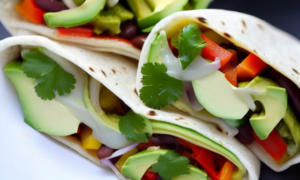 Diabetes-Friendly Veggie Fajitas: High in Fiber, Bursting with Flavor
Overview:
Indulge in the rich and vibrant flavors of these Diabetes-Friendly Veggie Fajitas, designed to be a nutritious and fiber-packed delight. Packed with sweet bell peppers, red onions, and wholesome black beans, these fajitas not only satisfy your taste buds but also cater to the dietary needs of individuals managing diabetes.
Ingredients:
2 tablespoons extra-virgin olive oil
4 small multicolored bell peppers, thinly sliced
1 large red onion, thinly sliced
1 (15-ounce) can no-salt-added black beans, rinsed
2 tablespoons water
1 tablespoon ground cumin
1 tablespoon chili powder
2 teaspoons smoked paprika
1/2 teaspoon salt
1/2 teaspoon ground pepper
1/4 cup chopped fresh cilantro, plus cilantro leaves for garnish
1/4 cup lime juice
12 (6-inch) corn tortillas, warmed
1/3 cup crumbled cotija cheese
2 small avocados, thinly sliced
Directions:
Heat oil in a large nonstick skillet over medium-high heat. Add bell peppers and onion; cook, stirring occasionally, until tender and slightly charred, about 12 minutes.
Stir in black beans, water, cumin, chili powder, paprika, salt, and pepper; cook, stirring often, until the beans are heated through, and the spices coat the vegetables, about 4 minutes. Remove from heat; stir in cilantro and lime juice.
Divide the flavorful mixture among tortillas; top with cotija and avocado. Garnish with cilantro leaves, if desired.
Diabetes-Friendly Benefits:
These Veggie Fajitas are a diabetes-friendly delight, offering a total of 16 grams of fiber per serving. The high-fiber content aids in blood sugar management by slowing down the digestion and absorption of carbohydrates. The colorful array of vegetables provides essential nutrients without compromising on flavor. Opting for whole-grain corn tortillas further contributes to better blood sugar control. This delicious and fiber-rich recipe is a smart choice for individuals with diabetes, offering a delightful way to savor the flavors while supporting overall health.
Diabetes-Friendly Veggie Fajitas: High in Fiber, Bursting with Flavor
Overview:
Indulge in the rich and vibrant flavors of these Diabetes-Friendly Veggie Fajitas, designed to be a nutritious and fiber-packed delight. Packed with sweet bell peppers, red onions, and wholesome black beans, these fajitas not only satisfy your taste buds but also cater to the dietary needs of individuals managing diabetes.
Ingredients:
2 tablespoons extra-virgin olive oil
4 small multicolored bell peppers, thinly sliced
1 large red onion, thinly sliced
1 (15-ounce) can no-salt-added black beans, rinsed
2 tablespoons water
1 tablespoon ground cumin
1 tablespoon chili powder
2 teaspoons smoked paprika
1/2 teaspoon salt
1/2 teaspoon ground pepper
1/4 cup chopped fresh cilantro, plus cilantro leaves for garnish
1/4 cup lime juice
12 (6-inch) corn tortillas, warmed
1/3 cup crumbled cotija cheese
2 small avocados, thinly sliced
Directions:
Heat oil in a large nonstick skillet over medium-high heat. Add bell peppers and onion; cook, stirring occasionally, until tender and slightly charred, about 12 minutes.
Stir in black beans, water, cumin, chili powder, paprika, salt, and pepper; cook, stirring often, until the beans are heated through, and the spices coat the vegetables, about 4 minutes. Remove from heat; stir in cilantro and lime juice.
Divide the flavorful mixture among tortillas; top with cotija and avocado. Garnish with cilantro leaves, if desired.
Diabetes-Friendly Benefits:
These Veggie Fajitas are a diabetes-friendly delight, offering a total of 16 grams of fiber per serving. The high-fiber content aids in blood sugar management by slowing down the digestion and absorption of carbohydrates. The colorful array of vegetables provides essential nutrients without compromising on flavor. Opting for whole-grain corn tortillas further contributes to better blood sugar control. This delicious and fiber-rich recipe is a smart choice for individuals with diabetes, offering a delightful way to savor the flavors while supporting overall health.
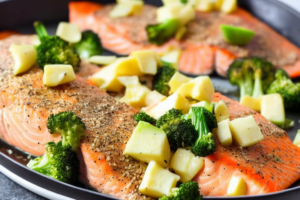 Simple Baked Salmon with Vegetable Salad
Main Course:
150g salmon (or other fish rich in omega-3 fatty acids): Provides high-quality protein for satiety and serves as a source of healthy fats.
Olive oil: Rich in healthy monounsaturated fats.
Vegetable Salad:
Spinach leaves, tomatoes, cucumbers, avocado, and red onions: Provides ample fiber, vitamins, and minerals, aiding in blood sugar control.
Orange Blossom Carrot Soup:
Carrots: High in fiber, contributing to stabilized blood sugar.
Low-sodium vegetable broth: Offers nutrition without excess sodium.
Orange juice: Adds natural sweetness to the soup without the need for added sugars.
Ginger and garlic: Provide flavor without additional sugars or sodium.
Fresh orange zest and juice: Enhance the soup's taste and nutritional profile.
Main Staple:
Brown rice or whole-grain rice: Supplies complex carbohydrates, helping maintain stable blood sugar levels.
Beverage:
Water or unsweetened red tea: Maintains hydration without additional sugars.
Why Suitable for Individuals with Diabetes:
Low sugar: Avoids high-sugar foods to help control blood sugar levels.
High fiber: Vegetables and whole grains offer rich fiber, slowing down carbohydrate absorption and stabilizing blood sugar.
Healthy fats: Salmon and olive oil provide healthy fats beneficial for cardiovascular health.
Carbohydrate control: Opting for complex carbohydrates over rapidly digestible ones helps maintain blood sugar balance.
This lunch recipe is designed to offer balanced nutrition, supporting individuals with diabetes in maintaining healthy eating habits and blood sugar control. Dietary plans should be moderately adjusted based on individual needs and doctor's recommendations.
Simple Baked Salmon with Vegetable Salad
Main Course:
150g salmon (or other fish rich in omega-3 fatty acids): Provides high-quality protein for satiety and serves as a source of healthy fats.
Olive oil: Rich in healthy monounsaturated fats.
Vegetable Salad:
Spinach leaves, tomatoes, cucumbers, avocado, and red onions: Provides ample fiber, vitamins, and minerals, aiding in blood sugar control.
Orange Blossom Carrot Soup:
Carrots: High in fiber, contributing to stabilized blood sugar.
Low-sodium vegetable broth: Offers nutrition without excess sodium.
Orange juice: Adds natural sweetness to the soup without the need for added sugars.
Ginger and garlic: Provide flavor without additional sugars or sodium.
Fresh orange zest and juice: Enhance the soup's taste and nutritional profile.
Main Staple:
Brown rice or whole-grain rice: Supplies complex carbohydrates, helping maintain stable blood sugar levels.
Beverage:
Water or unsweetened red tea: Maintains hydration without additional sugars.
Why Suitable for Individuals with Diabetes:
Low sugar: Avoids high-sugar foods to help control blood sugar levels.
High fiber: Vegetables and whole grains offer rich fiber, slowing down carbohydrate absorption and stabilizing blood sugar.
Healthy fats: Salmon and olive oil provide healthy fats beneficial for cardiovascular health.
Carbohydrate control: Opting for complex carbohydrates over rapidly digestible ones helps maintain blood sugar balance.
This lunch recipe is designed to offer balanced nutrition, supporting individuals with diabetes in maintaining healthy eating habits and blood sugar control. Dietary plans should be moderately adjusted based on individual needs and doctor's recommendations.
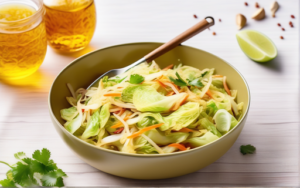 Sesame-Ginger Cabbage Stir-Fry
Ingredients:
2 tablespoons sesame oil8 cloves garlic, finely chopped2 tablespoons chopped unseeded jalapeño pepper1 tablespoon minced fresh ginger1/2 small head green cabbage, thinly sliced (approximately 8 cups)1 tablespoon reduced-sodium soy sauce1 tablespoon water1 teaspoon lime zest1 tablespoon lime juice1/4 teaspoon salt1/4 cup chopped fresh cilantro
Why Suitable for Diabetics:
This Sesame-Ginger Cabbage Stir-Fry not only delights the taste buds but also aligns well with diabetes-friendly dietary choices. Here's why:
1.Low-Glycemic Index Ingredients: Cabbage, garlic, ginger, and jalapeño are low-glycemic index ingredients, meaning they have a minimal impact on blood sugar levels.
2.Balanced Macronutrients: The combination of fiber-rich cabbage, healthy fats from sesame oil, and minimal added sugars supports a balanced meal that can assist in blood sugar management.
3.Reduced-Sodium Soy Sauce: The recipe incorporates reduced-sodium soy sauce, reducing sodium intake and promoting heart health, which is essential for individuals with diabetes.
4.Moderate Portion of Carbohydrates: The recipe is mindful of carbohydrate content, with the focus on non-starchy vegetables and controlled use of soy sauce, making it suitable for those monitoring carbohydrate intake.
Directions:
1.Heat Sesame Oil: In a large nonstick skillet or wok, heat sesame oil over medium-high heat.
2.Aromatics Infusion: Add finely chopped garlic, jalapeño, and minced fresh ginger. Cook, stirring constantly, until fragrant—approximately 20 seconds.
3.Add Cabbage: Incorporate thinly sliced green cabbage into the skillet. Stir constantly until the cabbage just begins to wilt, and the garlic achieves a light golden brown color—about 3 minutes.
4.Soy Infusion: Pour in reduced-sodium soy sauce, water, lime juice, and salt. Continue stirring constantly until the cabbage has wilted but remains crisp-tender—approximately 8 minutes.
5.Final Touch: Remove from heat. Stir in chopped fresh cilantro and lime zest.
Enjoy the diabetes-friendly benefits of this Sesame-Ginger Cabbage Stir-Fry—a flavorful, nutrient-packed dish that complements a balanced diet for individuals managing diabetes. Serve it as a side or light main course over rice or as is!
Sesame-Ginger Cabbage Stir-Fry
Ingredients:
2 tablespoons sesame oil8 cloves garlic, finely chopped2 tablespoons chopped unseeded jalapeño pepper1 tablespoon minced fresh ginger1/2 small head green cabbage, thinly sliced (approximately 8 cups)1 tablespoon reduced-sodium soy sauce1 tablespoon water1 teaspoon lime zest1 tablespoon lime juice1/4 teaspoon salt1/4 cup chopped fresh cilantro
Why Suitable for Diabetics:
This Sesame-Ginger Cabbage Stir-Fry not only delights the taste buds but also aligns well with diabetes-friendly dietary choices. Here's why:
1.Low-Glycemic Index Ingredients: Cabbage, garlic, ginger, and jalapeño are low-glycemic index ingredients, meaning they have a minimal impact on blood sugar levels.
2.Balanced Macronutrients: The combination of fiber-rich cabbage, healthy fats from sesame oil, and minimal added sugars supports a balanced meal that can assist in blood sugar management.
3.Reduced-Sodium Soy Sauce: The recipe incorporates reduced-sodium soy sauce, reducing sodium intake and promoting heart health, which is essential for individuals with diabetes.
4.Moderate Portion of Carbohydrates: The recipe is mindful of carbohydrate content, with the focus on non-starchy vegetables and controlled use of soy sauce, making it suitable for those monitoring carbohydrate intake.
Directions:
1.Heat Sesame Oil: In a large nonstick skillet or wok, heat sesame oil over medium-high heat.
2.Aromatics Infusion: Add finely chopped garlic, jalapeño, and minced fresh ginger. Cook, stirring constantly, until fragrant—approximately 20 seconds.
3.Add Cabbage: Incorporate thinly sliced green cabbage into the skillet. Stir constantly until the cabbage just begins to wilt, and the garlic achieves a light golden brown color—about 3 minutes.
4.Soy Infusion: Pour in reduced-sodium soy sauce, water, lime juice, and salt. Continue stirring constantly until the cabbage has wilted but remains crisp-tender—approximately 8 minutes.
5.Final Touch: Remove from heat. Stir in chopped fresh cilantro and lime zest.
Enjoy the diabetes-friendly benefits of this Sesame-Ginger Cabbage Stir-Fry—a flavorful, nutrient-packed dish that complements a balanced diet for individuals managing diabetes. Serve it as a side or light main course over rice or as is!
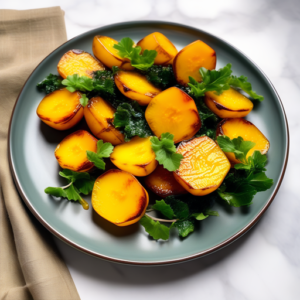 Honey-Glazed Roasted Golden Beets with Thyme
Ingredients:
4 medium golden beets, peeled and cut into 1-inch pieces2 tablespoons extra-virgin olive oil1 tablespoon honey1 tablespoon fresh thyme leaves1 medium clove garlic, finely chopped1/4 teaspoon ground pepper1/4 teaspoon salt, divided
Why Suitable for Diabetics:
This flavorful and nutritious Honey-Glazed Roasted Golden Beets with Thyme recipe is not only delicious but also diabetes-friendly. Here's why:
1.Low Glycemic Index Ingredients: Golden beets and garlic have a low glycemic index, meaning they have a smaller impact on blood sugar levels.
2.Moderate Honey Usage: The recipe incorporates a small amount of honey for sweetness. The quantity is moderate, providing a hint of sweetness without causing a significant spike in blood sugar.
3.Heart-Healthy Olive Oil: Extra-virgin olive oil is a healthy fat choice that can aid in managing blood sugar levels.
4.Balanced Macronutrients: The combination of beets, garlic, and thyme offers a mix of fiber, healthy fats, and antioxidants, contributing to a balanced meal suitable for those managing diabetes.
Directions:
1.Preheat Oven: Preheat the oven to 425°F. Line a large rimmed baking sheet with foil for easy cleanup.
2.Prepare Beets: In a large bowl, toss the peeled and cut golden beets with olive oil, honey, fresh thyme leaves, finely chopped garlic, ground pepper, and 1/8 teaspoon of salt until the beets are evenly coated.
3.Arrange on Baking Sheet: Spread the coated beets in an even layer on the prepared baking sheet.
4.Roast in the Oven: Roast the beets in the preheated oven for 35 to 40 minutes or until they turn a deep golden brown and become fork-tender. Stir the beets about every 10 minutes to ensure even cooking.
5.Final Touch: Once roasted, sprinkle the honey-glazed beets with the remaining 1/8 teaspoon of salt.
Enjoy the delightful flavors of these Honey-Glazed Roasted Golden Beets with Thyme as a savory side dish or a vibrant addition to your favorite salads!
Honey-Glazed Roasted Golden Beets with Thyme
Ingredients:
4 medium golden beets, peeled and cut into 1-inch pieces2 tablespoons extra-virgin olive oil1 tablespoon honey1 tablespoon fresh thyme leaves1 medium clove garlic, finely chopped1/4 teaspoon ground pepper1/4 teaspoon salt, divided
Why Suitable for Diabetics:
This flavorful and nutritious Honey-Glazed Roasted Golden Beets with Thyme recipe is not only delicious but also diabetes-friendly. Here's why:
1.Low Glycemic Index Ingredients: Golden beets and garlic have a low glycemic index, meaning they have a smaller impact on blood sugar levels.
2.Moderate Honey Usage: The recipe incorporates a small amount of honey for sweetness. The quantity is moderate, providing a hint of sweetness without causing a significant spike in blood sugar.
3.Heart-Healthy Olive Oil: Extra-virgin olive oil is a healthy fat choice that can aid in managing blood sugar levels.
4.Balanced Macronutrients: The combination of beets, garlic, and thyme offers a mix of fiber, healthy fats, and antioxidants, contributing to a balanced meal suitable for those managing diabetes.
Directions:
1.Preheat Oven: Preheat the oven to 425°F. Line a large rimmed baking sheet with foil for easy cleanup.
2.Prepare Beets: In a large bowl, toss the peeled and cut golden beets with olive oil, honey, fresh thyme leaves, finely chopped garlic, ground pepper, and 1/8 teaspoon of salt until the beets are evenly coated.
3.Arrange on Baking Sheet: Spread the coated beets in an even layer on the prepared baking sheet.
4.Roast in the Oven: Roast the beets in the preheated oven for 35 to 40 minutes or until they turn a deep golden brown and become fork-tender. Stir the beets about every 10 minutes to ensure even cooking.
5.Final Touch: Once roasted, sprinkle the honey-glazed beets with the remaining 1/8 teaspoon of salt.
Enjoy the delightful flavors of these Honey-Glazed Roasted Golden Beets with Thyme as a savory side dish or a vibrant addition to your favorite salads!
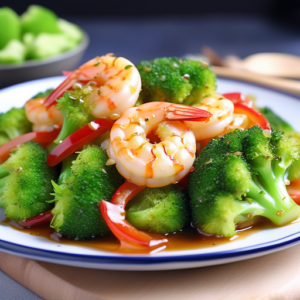 Lemon-Garlic Shrimp with Sautéed Broccoli
Ingredients:
3 tablespoons extra virgin olive oil, divided6 cloves medium-sized garlic, thinly sliced, divided4 cups small broccoli florets½ cup diced red bell pepper½ teaspoon salt, divided½ teaspoon black pepper, divided1 pound raw shrimp, peeled and deveined (21-30 count)2 teaspoons fresh lemon juice, plus extra for seasoning
Why Suitable for Diabetics:
This flavorful and nutritious Lemon-Garlic Shrimp with Sautéed Broccoli recipe is not only delicious but also diabetes-friendly. Here's why:
Low Glycemic Index Ingredients: Broccoli and bell peppers, being the main vegetables in this recipe, have a low glycemic index. This means they have a smaller impact on blood sugar levels.
Healthy Fats: The recipe incorporates extra virgin olive oil, a heart-healthy fat that can aid in managing blood sugar levels. It also provides a satisfying and rich flavor to the dish.
Lean Protein: Shrimp is a lean source of protein, which can help control blood sugar levels and promote satiety.
Balanced Macronutrients: The combination of protein, healthy fats, and fiber-rich vegetables contributes to a well-balanced meal that is suitable for those managing diabetes.
Instructions:
In a large skillet, heat 2 tablespoons of olive oil over medium heat. Add half of the sliced garlic and sauté for about 1 minute until it turns golden brown.
Introduce broccoli florets, diced bell pepper, 1/4 teaspoon of salt, and 1/4 teaspoon of black pepper to the skillet. Cover with a lid, stir occasionally, and if the skillet becomes too dry, add a tablespoon of water. Cook until the vegetables become tender, approximately 3 to 5 minutes. Transfer the mixture to a bowl, keeping it warm.
Increase the heat to medium-high and add the remaining 1 tablespoon of olive oil to the skillet. Add the remaining garlic and sauté for about 1 minute until golden brown.
Incorporate shrimp and the remaining 1/4 teaspoon of salt and black pepper. Cook, stirring constantly, until the shrimp are fully cooked, about 3 to 5 minutes.
Return the broccoli mixture to the skillet, add 2 teaspoons of fresh lemon juice, and stir to combine.
Enjoy the diabetes-friendly goodness of Lemon-Garlic Shrimp with Sautéed Broccoli! Adjust the seasoning with additional lemon juice according to your taste preferences.
Lemon-Garlic Shrimp with Sautéed Broccoli
Ingredients:
3 tablespoons extra virgin olive oil, divided6 cloves medium-sized garlic, thinly sliced, divided4 cups small broccoli florets½ cup diced red bell pepper½ teaspoon salt, divided½ teaspoon black pepper, divided1 pound raw shrimp, peeled and deveined (21-30 count)2 teaspoons fresh lemon juice, plus extra for seasoning
Why Suitable for Diabetics:
This flavorful and nutritious Lemon-Garlic Shrimp with Sautéed Broccoli recipe is not only delicious but also diabetes-friendly. Here's why:
Low Glycemic Index Ingredients: Broccoli and bell peppers, being the main vegetables in this recipe, have a low glycemic index. This means they have a smaller impact on blood sugar levels.
Healthy Fats: The recipe incorporates extra virgin olive oil, a heart-healthy fat that can aid in managing blood sugar levels. It also provides a satisfying and rich flavor to the dish.
Lean Protein: Shrimp is a lean source of protein, which can help control blood sugar levels and promote satiety.
Balanced Macronutrients: The combination of protein, healthy fats, and fiber-rich vegetables contributes to a well-balanced meal that is suitable for those managing diabetes.
Instructions:
In a large skillet, heat 2 tablespoons of olive oil over medium heat. Add half of the sliced garlic and sauté for about 1 minute until it turns golden brown.
Introduce broccoli florets, diced bell pepper, 1/4 teaspoon of salt, and 1/4 teaspoon of black pepper to the skillet. Cover with a lid, stir occasionally, and if the skillet becomes too dry, add a tablespoon of water. Cook until the vegetables become tender, approximately 3 to 5 minutes. Transfer the mixture to a bowl, keeping it warm.
Increase the heat to medium-high and add the remaining 1 tablespoon of olive oil to the skillet. Add the remaining garlic and sauté for about 1 minute until golden brown.
Incorporate shrimp and the remaining 1/4 teaspoon of salt and black pepper. Cook, stirring constantly, until the shrimp are fully cooked, about 3 to 5 minutes.
Return the broccoli mixture to the skillet, add 2 teaspoons of fresh lemon juice, and stir to combine.
Enjoy the diabetes-friendly goodness of Lemon-Garlic Shrimp with Sautéed Broccoli! Adjust the seasoning with additional lemon juice according to your taste preferences.
Classics Games
Hot Recipes
Latest Lists
 Nutrient-Rich Tomato Soup with Beans & Greens
Introduction:
Transform ordinary canned tomato soup into a hearty and wholesome meal in just 10 minutes! Garlicky kale and creamy white beans add depth and nutritional value to this quick and satisfying lunch or dinner option. This recipe is designed to be diabetes-friendly, emphasizing low-sodium choices and incorporating nutrient-rich ingredients.
Ingredients:
2 (14 ounce) cans low-sodium hearty-style tomato soup
1 tablespoon olive oil
3 cups chopped kale
1 teaspoon minced garlic
⅛ teaspoon crushed red pepper (Optional)
1 (14 ounce) can no-salt-added cannellini beans, rinsed
¼ cup grated Parmesan cheese
Directions:
Heat the tomato soup in a medium saucepan according to package directions; simmer over low heat while preparing the kale.
In a large skillet over medium heat, heat olive oil. Add kale and cook, stirring, until wilted, approximately 1 to 2 minutes. Stir in minced garlic and crushed red pepper (if using), cooking for an additional 30 seconds. Combine the sautéed greens and beans into the soup, simmering until the beans are heated through, around 2 to 3 minutes.
Divide the soup evenly among 4 bowls. Serve each portion topped with a sprinkle of Parmesan.
Diabetes-Friendly Features:
Low-Sodium Soup: Choose a low- or reduced-sodium tomato soup with no more than 450 mg sodium per serving, supporting heart health.
Leafy Greens: Kale adds essential vitamins and fiber without significantly affecting blood sugar levels.
Beans for Sustained Energy: Cannellini beans provide a protein and fiber boost, promoting stable blood sugar.
Healthy Fats: Olive oil contributes healthy monounsaturated fats, beneficial for cardiovascular health.
Moderate Parmesan Topping: A modest amount of Parmesan adds flavor without excess salt, complementing the dish.
Nutrient-Rich Tomato Soup with Beans & Greens
Introduction:
Transform ordinary canned tomato soup into a hearty and wholesome meal in just 10 minutes! Garlicky kale and creamy white beans add depth and nutritional value to this quick and satisfying lunch or dinner option. This recipe is designed to be diabetes-friendly, emphasizing low-sodium choices and incorporating nutrient-rich ingredients.
Ingredients:
2 (14 ounce) cans low-sodium hearty-style tomato soup
1 tablespoon olive oil
3 cups chopped kale
1 teaspoon minced garlic
⅛ teaspoon crushed red pepper (Optional)
1 (14 ounce) can no-salt-added cannellini beans, rinsed
¼ cup grated Parmesan cheese
Directions:
Heat the tomato soup in a medium saucepan according to package directions; simmer over low heat while preparing the kale.
In a large skillet over medium heat, heat olive oil. Add kale and cook, stirring, until wilted, approximately 1 to 2 minutes. Stir in minced garlic and crushed red pepper (if using), cooking for an additional 30 seconds. Combine the sautéed greens and beans into the soup, simmering until the beans are heated through, around 2 to 3 minutes.
Divide the soup evenly among 4 bowls. Serve each portion topped with a sprinkle of Parmesan.
Diabetes-Friendly Features:
Low-Sodium Soup: Choose a low- or reduced-sodium tomato soup with no more than 450 mg sodium per serving, supporting heart health.
Leafy Greens: Kale adds essential vitamins and fiber without significantly affecting blood sugar levels.
Beans for Sustained Energy: Cannellini beans provide a protein and fiber boost, promoting stable blood sugar.
Healthy Fats: Olive oil contributes healthy monounsaturated fats, beneficial for cardiovascular health.
Moderate Parmesan Topping: A modest amount of Parmesan adds flavor without excess salt, complementing the dish.
 Quick and Delicious 10-Minute Tuna Melt
Introduction:
This variation of a classic sandwich uses mayonnaise, but not where you think! Mayo is brushed on the outside of the sandwich in place of butter to make the sandwich golden and crispy as it heats in a skillet. Plain Greek yogurt takes mayo's place in the salad—along with crunchy celery, roasted red bell peppers, and scallions—for a satisfying lunch with less saturated fat.
Ingredients:
1 5-ounce can no-salt-added water-packed tuna, drained
1 small celery stalk, chopped
2 tablespoons chopped jarred roasted red pepper
1 scallion, minced
3 tablespoons low-fat plain Greek yogurt
1 teaspoon Dijon mustard
¼ teaspoon ground pepper
4 teaspoons mayonnaise or softened butter
4 slices whole-grain bread
2 slices sharp Cheddar cheese
Directions:
Stir tuna, celery, roasted red pepper, scallion, yogurt, mustard, and pepper together in a medium bowl until well blended.
Spread 1 teaspoon mayonnaise (or butter) on one side of each slice of bread. Flip 2 of the slices and top each with half of the tuna mixture, 1 slice cheese, and another slice of bread, mayonnaise-side up.
Heat a large skillet over medium heat. Place the sandwiches in the pan and cook, turning once, until the cheese is melted and the bread is golden, 3 to 5 minutes per side. Serve immediately.
Diabetes-Friendly Features:
Low Saturated Fat: Substitute low-fat Greek yogurt for mayonnaise to reduce saturated fat intake.
Whole-Grain Bread: Opt for whole-grain bread for stable carbohydrates, aiding in blood sugar management.
Vegetables and Protein: With celery, roasted red pepper, and tuna, it provides a balanced mix of vegetables and protein, helping control blood sugar.
Portion Control: The recipe emphasizes moderate ingredient quantities, aligning with diabetes dietary principles.
Quick and Delicious 10-Minute Tuna Melt
Introduction:
This variation of a classic sandwich uses mayonnaise, but not where you think! Mayo is brushed on the outside of the sandwich in place of butter to make the sandwich golden and crispy as it heats in a skillet. Plain Greek yogurt takes mayo's place in the salad—along with crunchy celery, roasted red bell peppers, and scallions—for a satisfying lunch with less saturated fat.
Ingredients:
1 5-ounce can no-salt-added water-packed tuna, drained
1 small celery stalk, chopped
2 tablespoons chopped jarred roasted red pepper
1 scallion, minced
3 tablespoons low-fat plain Greek yogurt
1 teaspoon Dijon mustard
¼ teaspoon ground pepper
4 teaspoons mayonnaise or softened butter
4 slices whole-grain bread
2 slices sharp Cheddar cheese
Directions:
Stir tuna, celery, roasted red pepper, scallion, yogurt, mustard, and pepper together in a medium bowl until well blended.
Spread 1 teaspoon mayonnaise (or butter) on one side of each slice of bread. Flip 2 of the slices and top each with half of the tuna mixture, 1 slice cheese, and another slice of bread, mayonnaise-side up.
Heat a large skillet over medium heat. Place the sandwiches in the pan and cook, turning once, until the cheese is melted and the bread is golden, 3 to 5 minutes per side. Serve immediately.
Diabetes-Friendly Features:
Low Saturated Fat: Substitute low-fat Greek yogurt for mayonnaise to reduce saturated fat intake.
Whole-Grain Bread: Opt for whole-grain bread for stable carbohydrates, aiding in blood sugar management.
Vegetables and Protein: With celery, roasted red pepper, and tuna, it provides a balanced mix of vegetables and protein, helping control blood sugar.
Portion Control: The recipe emphasizes moderate ingredient quantities, aligning with diabetes dietary principles.
 Linguine with Creamy White Clam Sauce
Overview:
Indulge in the delightful flavors of Linguine with Creamy White Clam Sauce, featuring ripe tomatoes, fresh basil, and tender clams. This quick and healthy pasta dish not only satisfies your taste buds but is also diabetes-friendly, offering a balance of wholesome ingredients.
Ingredients:
8 ounces whole-wheat linguine
1 16-ounce container chopped clams (thawed if frozen) or two 10-ounce cans whole baby clams
3 tablespoons extra-virgin olive oil
3 cloves garlic, chopped
¼ teaspoon crushed red pepper
1 tablespoon lemon juice
¼ teaspoon salt
1 large tomato, chopped
¼ cup chopped fresh basil, plus more for garnish
2 tablespoons heavy cream or half-and-half
Directions:
Bring a large saucepan of water to a boil. Add pasta and cook until just tender, about 8 minutes or according to package directions. Drain.
Meanwhile, drain clams, reserving 3/4 cup of the liquid. Heat oil in a large skillet over medium-high heat. Add garlic and crushed red pepper and cook, stirring, for 30 seconds.
Add the reserved clam liquid, lemon juice, and salt; bring to a simmer and cook until slightly reduced, 2 to 3 minutes. Add tomato and the clams; bring to a simmer and cook for 1 minute more. Remove from heat.
Stir in basil and cream (or half-and-half). Add the pasta and toss to coat with the sauce. Garnish with more basil, if desired.
Diabetes-Friendly Features:
Whole-Wheat Linguine: Incorporating whole grains provides complex carbohydrates, promoting steady blood sugar levels.
Fresh Ingredients: Ripe tomatoes and basil contribute natural flavors without added sugars, enhancing the nutritional profile.
Lean Protein: Clams offer protein without excessive fat, supporting a balanced meal for those managing diabetes.
Moderate Portions: The recipe emphasizes portion control, a crucial aspect of diabetes management.
Low-Sodium Option: Choosing fresh or frozen clams lowers sodium content compared to canned, aligning with dietary considerations for diabetes.
Linguine with Creamy White Clam Sauce
Overview:
Indulge in the delightful flavors of Linguine with Creamy White Clam Sauce, featuring ripe tomatoes, fresh basil, and tender clams. This quick and healthy pasta dish not only satisfies your taste buds but is also diabetes-friendly, offering a balance of wholesome ingredients.
Ingredients:
8 ounces whole-wheat linguine
1 16-ounce container chopped clams (thawed if frozen) or two 10-ounce cans whole baby clams
3 tablespoons extra-virgin olive oil
3 cloves garlic, chopped
¼ teaspoon crushed red pepper
1 tablespoon lemon juice
¼ teaspoon salt
1 large tomato, chopped
¼ cup chopped fresh basil, plus more for garnish
2 tablespoons heavy cream or half-and-half
Directions:
Bring a large saucepan of water to a boil. Add pasta and cook until just tender, about 8 minutes or according to package directions. Drain.
Meanwhile, drain clams, reserving 3/4 cup of the liquid. Heat oil in a large skillet over medium-high heat. Add garlic and crushed red pepper and cook, stirring, for 30 seconds.
Add the reserved clam liquid, lemon juice, and salt; bring to a simmer and cook until slightly reduced, 2 to 3 minutes. Add tomato and the clams; bring to a simmer and cook for 1 minute more. Remove from heat.
Stir in basil and cream (or half-and-half). Add the pasta and toss to coat with the sauce. Garnish with more basil, if desired.
Diabetes-Friendly Features:
Whole-Wheat Linguine: Incorporating whole grains provides complex carbohydrates, promoting steady blood sugar levels.
Fresh Ingredients: Ripe tomatoes and basil contribute natural flavors without added sugars, enhancing the nutritional profile.
Lean Protein: Clams offer protein without excessive fat, supporting a balanced meal for those managing diabetes.
Moderate Portions: The recipe emphasizes portion control, a crucial aspect of diabetes management.
Low-Sodium Option: Choosing fresh or frozen clams lowers sodium content compared to canned, aligning with dietary considerations for diabetes.
 Salmon-Stuffed Avocados
Overview:
Embrace a heart-healthy and diabetes-friendly meal with these Salmon-Stuffed Avocados. Featuring canned salmon, rich in omega-3 fatty acids, and avocados for a dose of wholesome fats, this no-cook dish is not only nutritious but also a convenient addition to your diabetes-friendly recipes.
Ingredients:
½ cup nonfat plain Greek yogurt
½ cup diced celery
2 tablespoons chopped fresh parsley
1 tablespoon lime juice
2 teaspoons mayonnaise
1 teaspoon Dijon mustard
⅛ teaspoon salt
⅛ teaspoon ground pepper
2 (5-ounce) cans salmon, drained, flaked, skin and bones removed
2 avocados
Chopped chives for garnish
Directions:
In a medium bowl, combine yogurt, celery, parsley, lime juice, mayonnaise, mustard, salt, and pepper. Mix well.
Add the drained and flaked salmon to the bowl and mix thoroughly.
Halve the avocados lengthwise, remove pits, and scoop about 1 tablespoon of flesh from each avocado half into a small bowl.
Mash the scooped-out avocado flesh with a fork and stir it into the salmon mixture.
Fill each avocado half with about 1/4 cup of the salmon mixture, mounding it on top of the avocado halves.
Garnish with chopped chives if desired.
Suitable for Diabetics:
This recipe is a diabetes-friendly choice as it incorporates nutrient-dense ingredients. Avocados offer healthy fats and fiber, while Greek yogurt provides protein without added sugars. The omega-3 fatty acids in salmon contribute to heart health, making it a balanced and delicious option for individuals managing diabetes.
Salmon-Stuffed Avocados
Overview:
Embrace a heart-healthy and diabetes-friendly meal with these Salmon-Stuffed Avocados. Featuring canned salmon, rich in omega-3 fatty acids, and avocados for a dose of wholesome fats, this no-cook dish is not only nutritious but also a convenient addition to your diabetes-friendly recipes.
Ingredients:
½ cup nonfat plain Greek yogurt
½ cup diced celery
2 tablespoons chopped fresh parsley
1 tablespoon lime juice
2 teaspoons mayonnaise
1 teaspoon Dijon mustard
⅛ teaspoon salt
⅛ teaspoon ground pepper
2 (5-ounce) cans salmon, drained, flaked, skin and bones removed
2 avocados
Chopped chives for garnish
Directions:
In a medium bowl, combine yogurt, celery, parsley, lime juice, mayonnaise, mustard, salt, and pepper. Mix well.
Add the drained and flaked salmon to the bowl and mix thoroughly.
Halve the avocados lengthwise, remove pits, and scoop about 1 tablespoon of flesh from each avocado half into a small bowl.
Mash the scooped-out avocado flesh with a fork and stir it into the salmon mixture.
Fill each avocado half with about 1/4 cup of the salmon mixture, mounding it on top of the avocado halves.
Garnish with chopped chives if desired.
Suitable for Diabetics:
This recipe is a diabetes-friendly choice as it incorporates nutrient-dense ingredients. Avocados offer healthy fats and fiber, while Greek yogurt provides protein without added sugars. The omega-3 fatty acids in salmon contribute to heart health, making it a balanced and delicious option for individuals managing diabetes.
 Quick Lemon Chicken Pasta
Overview:
Indulge in the fresh and flavorful delight of this Quick Lemon Chicken Pasta, a rapid and nutritious dinner option. Utilizing rotisserie chicken, spiralized zucchini, and the brightness of lemon, this dish is a delectable full meal ready in just 10 minutes!
Ingredients:
2 teaspoons extra-virgin olive oil
1 cup spiralized zucchini (see Tip)
1 cup baby spinach
½ cup shredded skinless rotisserie chicken breast
⅛ teaspoon salt
⅛ teaspoon ground pepper
½ cup cooked whole-wheat spaghetti
2 tablespoons grated Parmesan cheese
1 teaspoon grated lemon zest
1 tablespoon fresh lemon juice
1 tablespoon toasted panko breadcrumbs (see Tip)
Directions:
Heat oil in a large nonstick skillet over medium heat. Add zucchini; cook for 1 minute. Add spinach and chicken; cook for 1 more minute. Season with salt and pepper; remove from heat. Add cooked spaghetti, Parmesan, lemon zest, and lemon juice; toss to combine. Sprinkle with toasted panko and serve.
Tips:
Make your own zucchini noodles with a spiralizer; you'll need 1 small zucchini (about 2 oz.) for 1 cup of zoodles. Or look for a package of fresh zucchini noodles in the produce department.
To toast panko breadcrumbs: Set a small skillet over medium heat. Add panko and cook, stirring often, until golden, about 2 minutes. For extra flavor, melt 1 tsp. butter in the pan before toasting the breadcrumbs. Note that you can do this step first, using the same pan you'll use to prepare the rest of the recipe.
Suitable for Diabetics:
This recipe is light, low in calories, and an excellent choice for individuals with diabetes. Combining spiralized zucchini and whole-wheat spaghetti provides fiber and complex carbohydrates. The addition of lemon juice enhances the flavor without compromising blood sugar levels.
Quick Lemon Chicken Pasta
Overview:
Indulge in the fresh and flavorful delight of this Quick Lemon Chicken Pasta, a rapid and nutritious dinner option. Utilizing rotisserie chicken, spiralized zucchini, and the brightness of lemon, this dish is a delectable full meal ready in just 10 minutes!
Ingredients:
2 teaspoons extra-virgin olive oil
1 cup spiralized zucchini (see Tip)
1 cup baby spinach
½ cup shredded skinless rotisserie chicken breast
⅛ teaspoon salt
⅛ teaspoon ground pepper
½ cup cooked whole-wheat spaghetti
2 tablespoons grated Parmesan cheese
1 teaspoon grated lemon zest
1 tablespoon fresh lemon juice
1 tablespoon toasted panko breadcrumbs (see Tip)
Directions:
Heat oil in a large nonstick skillet over medium heat. Add zucchini; cook for 1 minute. Add spinach and chicken; cook for 1 more minute. Season with salt and pepper; remove from heat. Add cooked spaghetti, Parmesan, lemon zest, and lemon juice; toss to combine. Sprinkle with toasted panko and serve.
Tips:
Make your own zucchini noodles with a spiralizer; you'll need 1 small zucchini (about 2 oz.) for 1 cup of zoodles. Or look for a package of fresh zucchini noodles in the produce department.
To toast panko breadcrumbs: Set a small skillet over medium heat. Add panko and cook, stirring often, until golden, about 2 minutes. For extra flavor, melt 1 tsp. butter in the pan before toasting the breadcrumbs. Note that you can do this step first, using the same pan you'll use to prepare the rest of the recipe.
Suitable for Diabetics:
This recipe is light, low in calories, and an excellent choice for individuals with diabetes. Combining spiralized zucchini and whole-wheat spaghetti provides fiber and complex carbohydrates. The addition of lemon juice enhances the flavor without compromising blood sugar levels.
 Diabetes-Friendly One-Pan Chicken & Cabbage with Rice
Overview:
Indulge in the delightful flavors of this One-Pan Chicken & Cabbage with Rice—a tasteful and diabetes-friendly dish. Crafted with a balance of wholesome ingredients, this recipe ensures a delicious and nourishing experience for individuals managing diabetes.
Ingredients:
2 1/4 cups reduced-sodium chicken broth
2 tablespoons lemon juice
1 tablespoon Dijon mustard
1 teaspoon chopped fresh oregano, plus more for garnish
2 tablespoons extra-virgin olive oil, divided
3/4 teaspoon salt, divided
1/2 teaspoon ground pepper, divided
4 (6-ounce) bone-in, skin-on chicken thighs
1 small head green cabbage (about 16 ounces), cut into 6 (1 1/2- to 2-inch-thick) wedges
1 cup brown basmati rice
1/4 cup crumbled feta cheese
Lemon wedges for serving (optional)
Directions:
Preheat oven to 350°F. Whisk broth, lemon juice, mustard, oregano, 1 tablespoon oil, 1/2 teaspoon salt, and 1/4 teaspoon pepper together in a medium bowl until combined.
Sprinkle chicken with the remaining 1/4 teaspoon each salt and pepper. Heat the remaining 1 tablespoon oil in a large oven-safe skillet over medium-high heat. Add the chicken, skin-sides down; cook until the skins are golden brown and crispy, about 6 minutes. Transfer the chicken to a plate.
Add cabbage wedges to the pan; cook until slightly charred and beginning to become tender, 2 to 3 minutes per side. Transfer to a separate plate.
Reduce heat to medium; cook rice, stirring constantly, until toasted and fragrant, about 1 minute. Stir in the broth mixture until evenly combined.
Nestle the cabbage wedges and the chicken, skin-sides up, in a single layer in the rice mixture. Bring to a boil over medium-high heat. Remove from heat and cover with a tight-fitting lid.
Transfer to the oven and bake until the liquid is absorbed, the rice is tender, and an instant-read thermometer inserted into the thickest portion of chicken registers at least 165°F, about 45 minutes. Remove the lid; bake until the chicken skins crisp up slightly, about 6 minutes. Top evenly with feta. Garnish with oregano and serve with lemon wedges, if desired.
Diabetes-Friendly Benefits:
This diabetes-friendly recipe incorporates brown basmati rice, a low-glycemic index option that helps regulate blood sugar levels. The chicken provides lean protein, and the cabbage contributes fiber and essential nutrients. The recipe is thoughtfully designed to maintain a balance between flavors and nutritional requirements, making it a wholesome and diabetes-conscious choice for a satisfying meal.
Diabetes-Friendly One-Pan Chicken & Cabbage with Rice
Overview:
Indulge in the delightful flavors of this One-Pan Chicken & Cabbage with Rice—a tasteful and diabetes-friendly dish. Crafted with a balance of wholesome ingredients, this recipe ensures a delicious and nourishing experience for individuals managing diabetes.
Ingredients:
2 1/4 cups reduced-sodium chicken broth
2 tablespoons lemon juice
1 tablespoon Dijon mustard
1 teaspoon chopped fresh oregano, plus more for garnish
2 tablespoons extra-virgin olive oil, divided
3/4 teaspoon salt, divided
1/2 teaspoon ground pepper, divided
4 (6-ounce) bone-in, skin-on chicken thighs
1 small head green cabbage (about 16 ounces), cut into 6 (1 1/2- to 2-inch-thick) wedges
1 cup brown basmati rice
1/4 cup crumbled feta cheese
Lemon wedges for serving (optional)
Directions:
Preheat oven to 350°F. Whisk broth, lemon juice, mustard, oregano, 1 tablespoon oil, 1/2 teaspoon salt, and 1/4 teaspoon pepper together in a medium bowl until combined.
Sprinkle chicken with the remaining 1/4 teaspoon each salt and pepper. Heat the remaining 1 tablespoon oil in a large oven-safe skillet over medium-high heat. Add the chicken, skin-sides down; cook until the skins are golden brown and crispy, about 6 minutes. Transfer the chicken to a plate.
Add cabbage wedges to the pan; cook until slightly charred and beginning to become tender, 2 to 3 minutes per side. Transfer to a separate plate.
Reduce heat to medium; cook rice, stirring constantly, until toasted and fragrant, about 1 minute. Stir in the broth mixture until evenly combined.
Nestle the cabbage wedges and the chicken, skin-sides up, in a single layer in the rice mixture. Bring to a boil over medium-high heat. Remove from heat and cover with a tight-fitting lid.
Transfer to the oven and bake until the liquid is absorbed, the rice is tender, and an instant-read thermometer inserted into the thickest portion of chicken registers at least 165°F, about 45 minutes. Remove the lid; bake until the chicken skins crisp up slightly, about 6 minutes. Top evenly with feta. Garnish with oregano and serve with lemon wedges, if desired.
Diabetes-Friendly Benefits:
This diabetes-friendly recipe incorporates brown basmati rice, a low-glycemic index option that helps regulate blood sugar levels. The chicken provides lean protein, and the cabbage contributes fiber and essential nutrients. The recipe is thoughtfully designed to maintain a balance between flavors and nutritional requirements, making it a wholesome and diabetes-conscious choice for a satisfying meal.
 Diabetes-Friendly Chicken Noodle Soup with Spinach & Parmesan
Overview:
Delight in the comforting flavors of Chicken Noodle Soup with Spinach & Parmesan, a diabetes-friendly recipe that balances taste and nutritional benefits. This soup is thoughtfully crafted to cater to the dietary needs of individuals managing diabetes, ensuring a delicious and wholesome meal.
Ingredients:
2 tablespoons extra virgin olive oil
2 cloves garlic, thinly sliced
1/4 teaspoon crushed red pepper
1/3 cup dry white wine
6 cups low-sodium chicken broth
1/4 teaspoon salt
1/4 teaspoon ground pepper
1/2 cup whole-wheat small elbow pasta
2 cups shredded cooked chicken breast
1 (5-ounce) package baby spinach
1/2 teaspoon lemon zest
2 tablespoons lemon juice
1/3 cup finely grated Parmesan cheese
Directions:
Cook oil, garlic, and crushed red pepper in a medium saucepan over medium-high heat, stirring constantly until fragrant and sizzling, about 2 minutes. Stir in wine; cook, stirring once, until reduced by half, about 2 minutes.
Stir in broth, salt, and pepper. Cover and bring to a boil over high heat. Add pasta; cook, stirring occasionally, until al dente, about 6 minutes.
Remove from heat. Add chicken and spinach; stir until the spinach is wilted, about 1 minute. Stir in lemon zest and lemon juice.
Divide the soup among 4 shallow bowls; sprinkle with Parmesan.
Diabetes-Friendly Benefits:
This Chicken Noodle Soup is tailored for individuals managing diabetes. The whole-wheat pasta provides complex carbohydrates, promoting stable blood sugar levels. The addition of lean shredded chicken ensures a protein boost without excess saturated fats. Spinach, rich in fiber and essential nutrients, contributes to a balanced meal. The soup's flavor is elevated with a touch of white wine, garlic, and Parmesan, making it a satisfying and diabetes-conscious choice for a nourishing meal.
Diabetes-Friendly Chicken Noodle Soup with Spinach & Parmesan
Overview:
Delight in the comforting flavors of Chicken Noodle Soup with Spinach & Parmesan, a diabetes-friendly recipe that balances taste and nutritional benefits. This soup is thoughtfully crafted to cater to the dietary needs of individuals managing diabetes, ensuring a delicious and wholesome meal.
Ingredients:
2 tablespoons extra virgin olive oil
2 cloves garlic, thinly sliced
1/4 teaspoon crushed red pepper
1/3 cup dry white wine
6 cups low-sodium chicken broth
1/4 teaspoon salt
1/4 teaspoon ground pepper
1/2 cup whole-wheat small elbow pasta
2 cups shredded cooked chicken breast
1 (5-ounce) package baby spinach
1/2 teaspoon lemon zest
2 tablespoons lemon juice
1/3 cup finely grated Parmesan cheese
Directions:
Cook oil, garlic, and crushed red pepper in a medium saucepan over medium-high heat, stirring constantly until fragrant and sizzling, about 2 minutes. Stir in wine; cook, stirring once, until reduced by half, about 2 minutes.
Stir in broth, salt, and pepper. Cover and bring to a boil over high heat. Add pasta; cook, stirring occasionally, until al dente, about 6 minutes.
Remove from heat. Add chicken and spinach; stir until the spinach is wilted, about 1 minute. Stir in lemon zest and lemon juice.
Divide the soup among 4 shallow bowls; sprinkle with Parmesan.
Diabetes-Friendly Benefits:
This Chicken Noodle Soup is tailored for individuals managing diabetes. The whole-wheat pasta provides complex carbohydrates, promoting stable blood sugar levels. The addition of lean shredded chicken ensures a protein boost without excess saturated fats. Spinach, rich in fiber and essential nutrients, contributes to a balanced meal. The soup's flavor is elevated with a touch of white wine, garlic, and Parmesan, making it a satisfying and diabetes-conscious choice for a nourishing meal.
 Diabetes-Friendly Veggie Fajitas: High in Fiber, Bursting with Flavor
Overview:
Indulge in the rich and vibrant flavors of these Diabetes-Friendly Veggie Fajitas, designed to be a nutritious and fiber-packed delight. Packed with sweet bell peppers, red onions, and wholesome black beans, these fajitas not only satisfy your taste buds but also cater to the dietary needs of individuals managing diabetes.
Ingredients:
2 tablespoons extra-virgin olive oil
4 small multicolored bell peppers, thinly sliced
1 large red onion, thinly sliced
1 (15-ounce) can no-salt-added black beans, rinsed
2 tablespoons water
1 tablespoon ground cumin
1 tablespoon chili powder
2 teaspoons smoked paprika
1/2 teaspoon salt
1/2 teaspoon ground pepper
1/4 cup chopped fresh cilantro, plus cilantro leaves for garnish
1/4 cup lime juice
12 (6-inch) corn tortillas, warmed
1/3 cup crumbled cotija cheese
2 small avocados, thinly sliced
Directions:
Heat oil in a large nonstick skillet over medium-high heat. Add bell peppers and onion; cook, stirring occasionally, until tender and slightly charred, about 12 minutes.
Stir in black beans, water, cumin, chili powder, paprika, salt, and pepper; cook, stirring often, until the beans are heated through, and the spices coat the vegetables, about 4 minutes. Remove from heat; stir in cilantro and lime juice.
Divide the flavorful mixture among tortillas; top with cotija and avocado. Garnish with cilantro leaves, if desired.
Diabetes-Friendly Benefits:
These Veggie Fajitas are a diabetes-friendly delight, offering a total of 16 grams of fiber per serving. The high-fiber content aids in blood sugar management by slowing down the digestion and absorption of carbohydrates. The colorful array of vegetables provides essential nutrients without compromising on flavor. Opting for whole-grain corn tortillas further contributes to better blood sugar control. This delicious and fiber-rich recipe is a smart choice for individuals with diabetes, offering a delightful way to savor the flavors while supporting overall health.
Diabetes-Friendly Veggie Fajitas: High in Fiber, Bursting with Flavor
Overview:
Indulge in the rich and vibrant flavors of these Diabetes-Friendly Veggie Fajitas, designed to be a nutritious and fiber-packed delight. Packed with sweet bell peppers, red onions, and wholesome black beans, these fajitas not only satisfy your taste buds but also cater to the dietary needs of individuals managing diabetes.
Ingredients:
2 tablespoons extra-virgin olive oil
4 small multicolored bell peppers, thinly sliced
1 large red onion, thinly sliced
1 (15-ounce) can no-salt-added black beans, rinsed
2 tablespoons water
1 tablespoon ground cumin
1 tablespoon chili powder
2 teaspoons smoked paprika
1/2 teaspoon salt
1/2 teaspoon ground pepper
1/4 cup chopped fresh cilantro, plus cilantro leaves for garnish
1/4 cup lime juice
12 (6-inch) corn tortillas, warmed
1/3 cup crumbled cotija cheese
2 small avocados, thinly sliced
Directions:
Heat oil in a large nonstick skillet over medium-high heat. Add bell peppers and onion; cook, stirring occasionally, until tender and slightly charred, about 12 minutes.
Stir in black beans, water, cumin, chili powder, paprika, salt, and pepper; cook, stirring often, until the beans are heated through, and the spices coat the vegetables, about 4 minutes. Remove from heat; stir in cilantro and lime juice.
Divide the flavorful mixture among tortillas; top with cotija and avocado. Garnish with cilantro leaves, if desired.
Diabetes-Friendly Benefits:
These Veggie Fajitas are a diabetes-friendly delight, offering a total of 16 grams of fiber per serving. The high-fiber content aids in blood sugar management by slowing down the digestion and absorption of carbohydrates. The colorful array of vegetables provides essential nutrients without compromising on flavor. Opting for whole-grain corn tortillas further contributes to better blood sugar control. This delicious and fiber-rich recipe is a smart choice for individuals with diabetes, offering a delightful way to savor the flavors while supporting overall health.
 Simple Baked Salmon with Vegetable Salad
Main Course:
150g salmon (or other fish rich in omega-3 fatty acids): Provides high-quality protein for satiety and serves as a source of healthy fats.
Olive oil: Rich in healthy monounsaturated fats.
Vegetable Salad:
Spinach leaves, tomatoes, cucumbers, avocado, and red onions: Provides ample fiber, vitamins, and minerals, aiding in blood sugar control.
Orange Blossom Carrot Soup:
Carrots: High in fiber, contributing to stabilized blood sugar.
Low-sodium vegetable broth: Offers nutrition without excess sodium.
Orange juice: Adds natural sweetness to the soup without the need for added sugars.
Ginger and garlic: Provide flavor without additional sugars or sodium.
Fresh orange zest and juice: Enhance the soup's taste and nutritional profile.
Main Staple:
Brown rice or whole-grain rice: Supplies complex carbohydrates, helping maintain stable blood sugar levels.
Beverage:
Water or unsweetened red tea: Maintains hydration without additional sugars.
Why Suitable for Individuals with Diabetes:
Low sugar: Avoids high-sugar foods to help control blood sugar levels.
High fiber: Vegetables and whole grains offer rich fiber, slowing down carbohydrate absorption and stabilizing blood sugar.
Healthy fats: Salmon and olive oil provide healthy fats beneficial for cardiovascular health.
Carbohydrate control: Opting for complex carbohydrates over rapidly digestible ones helps maintain blood sugar balance.
This lunch recipe is designed to offer balanced nutrition, supporting individuals with diabetes in maintaining healthy eating habits and blood sugar control. Dietary plans should be moderately adjusted based on individual needs and doctor's recommendations.
Simple Baked Salmon with Vegetable Salad
Main Course:
150g salmon (or other fish rich in omega-3 fatty acids): Provides high-quality protein for satiety and serves as a source of healthy fats.
Olive oil: Rich in healthy monounsaturated fats.
Vegetable Salad:
Spinach leaves, tomatoes, cucumbers, avocado, and red onions: Provides ample fiber, vitamins, and minerals, aiding in blood sugar control.
Orange Blossom Carrot Soup:
Carrots: High in fiber, contributing to stabilized blood sugar.
Low-sodium vegetable broth: Offers nutrition without excess sodium.
Orange juice: Adds natural sweetness to the soup without the need for added sugars.
Ginger and garlic: Provide flavor without additional sugars or sodium.
Fresh orange zest and juice: Enhance the soup's taste and nutritional profile.
Main Staple:
Brown rice or whole-grain rice: Supplies complex carbohydrates, helping maintain stable blood sugar levels.
Beverage:
Water or unsweetened red tea: Maintains hydration without additional sugars.
Why Suitable for Individuals with Diabetes:
Low sugar: Avoids high-sugar foods to help control blood sugar levels.
High fiber: Vegetables and whole grains offer rich fiber, slowing down carbohydrate absorption and stabilizing blood sugar.
Healthy fats: Salmon and olive oil provide healthy fats beneficial for cardiovascular health.
Carbohydrate control: Opting for complex carbohydrates over rapidly digestible ones helps maintain blood sugar balance.
This lunch recipe is designed to offer balanced nutrition, supporting individuals with diabetes in maintaining healthy eating habits and blood sugar control. Dietary plans should be moderately adjusted based on individual needs and doctor's recommendations.
 Sesame-Ginger Cabbage Stir-Fry
Ingredients:
2 tablespoons sesame oil8 cloves garlic, finely chopped2 tablespoons chopped unseeded jalapeño pepper1 tablespoon minced fresh ginger1/2 small head green cabbage, thinly sliced (approximately 8 cups)1 tablespoon reduced-sodium soy sauce1 tablespoon water1 teaspoon lime zest1 tablespoon lime juice1/4 teaspoon salt1/4 cup chopped fresh cilantro
Why Suitable for Diabetics:
This Sesame-Ginger Cabbage Stir-Fry not only delights the taste buds but also aligns well with diabetes-friendly dietary choices. Here's why:
1.Low-Glycemic Index Ingredients: Cabbage, garlic, ginger, and jalapeño are low-glycemic index ingredients, meaning they have a minimal impact on blood sugar levels.
2.Balanced Macronutrients: The combination of fiber-rich cabbage, healthy fats from sesame oil, and minimal added sugars supports a balanced meal that can assist in blood sugar management.
3.Reduced-Sodium Soy Sauce: The recipe incorporates reduced-sodium soy sauce, reducing sodium intake and promoting heart health, which is essential for individuals with diabetes.
4.Moderate Portion of Carbohydrates: The recipe is mindful of carbohydrate content, with the focus on non-starchy vegetables and controlled use of soy sauce, making it suitable for those monitoring carbohydrate intake.
Directions:
1.Heat Sesame Oil: In a large nonstick skillet or wok, heat sesame oil over medium-high heat.
2.Aromatics Infusion: Add finely chopped garlic, jalapeño, and minced fresh ginger. Cook, stirring constantly, until fragrant—approximately 20 seconds.
3.Add Cabbage: Incorporate thinly sliced green cabbage into the skillet. Stir constantly until the cabbage just begins to wilt, and the garlic achieves a light golden brown color—about 3 minutes.
4.Soy Infusion: Pour in reduced-sodium soy sauce, water, lime juice, and salt. Continue stirring constantly until the cabbage has wilted but remains crisp-tender—approximately 8 minutes.
5.Final Touch: Remove from heat. Stir in chopped fresh cilantro and lime zest.
Enjoy the diabetes-friendly benefits of this Sesame-Ginger Cabbage Stir-Fry—a flavorful, nutrient-packed dish that complements a balanced diet for individuals managing diabetes. Serve it as a side or light main course over rice or as is!
Sesame-Ginger Cabbage Stir-Fry
Ingredients:
2 tablespoons sesame oil8 cloves garlic, finely chopped2 tablespoons chopped unseeded jalapeño pepper1 tablespoon minced fresh ginger1/2 small head green cabbage, thinly sliced (approximately 8 cups)1 tablespoon reduced-sodium soy sauce1 tablespoon water1 teaspoon lime zest1 tablespoon lime juice1/4 teaspoon salt1/4 cup chopped fresh cilantro
Why Suitable for Diabetics:
This Sesame-Ginger Cabbage Stir-Fry not only delights the taste buds but also aligns well with diabetes-friendly dietary choices. Here's why:
1.Low-Glycemic Index Ingredients: Cabbage, garlic, ginger, and jalapeño are low-glycemic index ingredients, meaning they have a minimal impact on blood sugar levels.
2.Balanced Macronutrients: The combination of fiber-rich cabbage, healthy fats from sesame oil, and minimal added sugars supports a balanced meal that can assist in blood sugar management.
3.Reduced-Sodium Soy Sauce: The recipe incorporates reduced-sodium soy sauce, reducing sodium intake and promoting heart health, which is essential for individuals with diabetes.
4.Moderate Portion of Carbohydrates: The recipe is mindful of carbohydrate content, with the focus on non-starchy vegetables and controlled use of soy sauce, making it suitable for those monitoring carbohydrate intake.
Directions:
1.Heat Sesame Oil: In a large nonstick skillet or wok, heat sesame oil over medium-high heat.
2.Aromatics Infusion: Add finely chopped garlic, jalapeño, and minced fresh ginger. Cook, stirring constantly, until fragrant—approximately 20 seconds.
3.Add Cabbage: Incorporate thinly sliced green cabbage into the skillet. Stir constantly until the cabbage just begins to wilt, and the garlic achieves a light golden brown color—about 3 minutes.
4.Soy Infusion: Pour in reduced-sodium soy sauce, water, lime juice, and salt. Continue stirring constantly until the cabbage has wilted but remains crisp-tender—approximately 8 minutes.
5.Final Touch: Remove from heat. Stir in chopped fresh cilantro and lime zest.
Enjoy the diabetes-friendly benefits of this Sesame-Ginger Cabbage Stir-Fry—a flavorful, nutrient-packed dish that complements a balanced diet for individuals managing diabetes. Serve it as a side or light main course over rice or as is!
 Honey-Glazed Roasted Golden Beets with Thyme
Ingredients:
4 medium golden beets, peeled and cut into 1-inch pieces2 tablespoons extra-virgin olive oil1 tablespoon honey1 tablespoon fresh thyme leaves1 medium clove garlic, finely chopped1/4 teaspoon ground pepper1/4 teaspoon salt, divided
Why Suitable for Diabetics:
This flavorful and nutritious Honey-Glazed Roasted Golden Beets with Thyme recipe is not only delicious but also diabetes-friendly. Here's why:
1.Low Glycemic Index Ingredients: Golden beets and garlic have a low glycemic index, meaning they have a smaller impact on blood sugar levels.
2.Moderate Honey Usage: The recipe incorporates a small amount of honey for sweetness. The quantity is moderate, providing a hint of sweetness without causing a significant spike in blood sugar.
3.Heart-Healthy Olive Oil: Extra-virgin olive oil is a healthy fat choice that can aid in managing blood sugar levels.
4.Balanced Macronutrients: The combination of beets, garlic, and thyme offers a mix of fiber, healthy fats, and antioxidants, contributing to a balanced meal suitable for those managing diabetes.
Directions:
1.Preheat Oven: Preheat the oven to 425°F. Line a large rimmed baking sheet with foil for easy cleanup.
2.Prepare Beets: In a large bowl, toss the peeled and cut golden beets with olive oil, honey, fresh thyme leaves, finely chopped garlic, ground pepper, and 1/8 teaspoon of salt until the beets are evenly coated.
3.Arrange on Baking Sheet: Spread the coated beets in an even layer on the prepared baking sheet.
4.Roast in the Oven: Roast the beets in the preheated oven for 35 to 40 minutes or until they turn a deep golden brown and become fork-tender. Stir the beets about every 10 minutes to ensure even cooking.
5.Final Touch: Once roasted, sprinkle the honey-glazed beets with the remaining 1/8 teaspoon of salt.
Enjoy the delightful flavors of these Honey-Glazed Roasted Golden Beets with Thyme as a savory side dish or a vibrant addition to your favorite salads!
Honey-Glazed Roasted Golden Beets with Thyme
Ingredients:
4 medium golden beets, peeled and cut into 1-inch pieces2 tablespoons extra-virgin olive oil1 tablespoon honey1 tablespoon fresh thyme leaves1 medium clove garlic, finely chopped1/4 teaspoon ground pepper1/4 teaspoon salt, divided
Why Suitable for Diabetics:
This flavorful and nutritious Honey-Glazed Roasted Golden Beets with Thyme recipe is not only delicious but also diabetes-friendly. Here's why:
1.Low Glycemic Index Ingredients: Golden beets and garlic have a low glycemic index, meaning they have a smaller impact on blood sugar levels.
2.Moderate Honey Usage: The recipe incorporates a small amount of honey for sweetness. The quantity is moderate, providing a hint of sweetness without causing a significant spike in blood sugar.
3.Heart-Healthy Olive Oil: Extra-virgin olive oil is a healthy fat choice that can aid in managing blood sugar levels.
4.Balanced Macronutrients: The combination of beets, garlic, and thyme offers a mix of fiber, healthy fats, and antioxidants, contributing to a balanced meal suitable for those managing diabetes.
Directions:
1.Preheat Oven: Preheat the oven to 425°F. Line a large rimmed baking sheet with foil for easy cleanup.
2.Prepare Beets: In a large bowl, toss the peeled and cut golden beets with olive oil, honey, fresh thyme leaves, finely chopped garlic, ground pepper, and 1/8 teaspoon of salt until the beets are evenly coated.
3.Arrange on Baking Sheet: Spread the coated beets in an even layer on the prepared baking sheet.
4.Roast in the Oven: Roast the beets in the preheated oven for 35 to 40 minutes or until they turn a deep golden brown and become fork-tender. Stir the beets about every 10 minutes to ensure even cooking.
5.Final Touch: Once roasted, sprinkle the honey-glazed beets with the remaining 1/8 teaspoon of salt.
Enjoy the delightful flavors of these Honey-Glazed Roasted Golden Beets with Thyme as a savory side dish or a vibrant addition to your favorite salads!
 Lemon-Garlic Shrimp with Sautéed Broccoli
Ingredients:
3 tablespoons extra virgin olive oil, divided6 cloves medium-sized garlic, thinly sliced, divided4 cups small broccoli florets½ cup diced red bell pepper½ teaspoon salt, divided½ teaspoon black pepper, divided1 pound raw shrimp, peeled and deveined (21-30 count)2 teaspoons fresh lemon juice, plus extra for seasoning
Why Suitable for Diabetics:
This flavorful and nutritious Lemon-Garlic Shrimp with Sautéed Broccoli recipe is not only delicious but also diabetes-friendly. Here's why:
Low Glycemic Index Ingredients: Broccoli and bell peppers, being the main vegetables in this recipe, have a low glycemic index. This means they have a smaller impact on blood sugar levels.
Healthy Fats: The recipe incorporates extra virgin olive oil, a heart-healthy fat that can aid in managing blood sugar levels. It also provides a satisfying and rich flavor to the dish.
Lean Protein: Shrimp is a lean source of protein, which can help control blood sugar levels and promote satiety.
Balanced Macronutrients: The combination of protein, healthy fats, and fiber-rich vegetables contributes to a well-balanced meal that is suitable for those managing diabetes.
Instructions:
In a large skillet, heat 2 tablespoons of olive oil over medium heat. Add half of the sliced garlic and sauté for about 1 minute until it turns golden brown.
Introduce broccoli florets, diced bell pepper, 1/4 teaspoon of salt, and 1/4 teaspoon of black pepper to the skillet. Cover with a lid, stir occasionally, and if the skillet becomes too dry, add a tablespoon of water. Cook until the vegetables become tender, approximately 3 to 5 minutes. Transfer the mixture to a bowl, keeping it warm.
Increase the heat to medium-high and add the remaining 1 tablespoon of olive oil to the skillet. Add the remaining garlic and sauté for about 1 minute until golden brown.
Incorporate shrimp and the remaining 1/4 teaspoon of salt and black pepper. Cook, stirring constantly, until the shrimp are fully cooked, about 3 to 5 minutes.
Return the broccoli mixture to the skillet, add 2 teaspoons of fresh lemon juice, and stir to combine.
Enjoy the diabetes-friendly goodness of Lemon-Garlic Shrimp with Sautéed Broccoli! Adjust the seasoning with additional lemon juice according to your taste preferences.
Lemon-Garlic Shrimp with Sautéed Broccoli
Ingredients:
3 tablespoons extra virgin olive oil, divided6 cloves medium-sized garlic, thinly sliced, divided4 cups small broccoli florets½ cup diced red bell pepper½ teaspoon salt, divided½ teaspoon black pepper, divided1 pound raw shrimp, peeled and deveined (21-30 count)2 teaspoons fresh lemon juice, plus extra for seasoning
Why Suitable for Diabetics:
This flavorful and nutritious Lemon-Garlic Shrimp with Sautéed Broccoli recipe is not only delicious but also diabetes-friendly. Here's why:
Low Glycemic Index Ingredients: Broccoli and bell peppers, being the main vegetables in this recipe, have a low glycemic index. This means they have a smaller impact on blood sugar levels.
Healthy Fats: The recipe incorporates extra virgin olive oil, a heart-healthy fat that can aid in managing blood sugar levels. It also provides a satisfying and rich flavor to the dish.
Lean Protein: Shrimp is a lean source of protein, which can help control blood sugar levels and promote satiety.
Balanced Macronutrients: The combination of protein, healthy fats, and fiber-rich vegetables contributes to a well-balanced meal that is suitable for those managing diabetes.
Instructions:
In a large skillet, heat 2 tablespoons of olive oil over medium heat. Add half of the sliced garlic and sauté for about 1 minute until it turns golden brown.
Introduce broccoli florets, diced bell pepper, 1/4 teaspoon of salt, and 1/4 teaspoon of black pepper to the skillet. Cover with a lid, stir occasionally, and if the skillet becomes too dry, add a tablespoon of water. Cook until the vegetables become tender, approximately 3 to 5 minutes. Transfer the mixture to a bowl, keeping it warm.
Increase the heat to medium-high and add the remaining 1 tablespoon of olive oil to the skillet. Add the remaining garlic and sauté for about 1 minute until golden brown.
Incorporate shrimp and the remaining 1/4 teaspoon of salt and black pepper. Cook, stirring constantly, until the shrimp are fully cooked, about 3 to 5 minutes.
Return the broccoli mixture to the skillet, add 2 teaspoons of fresh lemon juice, and stir to combine.
Enjoy the diabetes-friendly goodness of Lemon-Garlic Shrimp with Sautéed Broccoli! Adjust the seasoning with additional lemon juice according to your taste preferences.

 Follow
Follow



